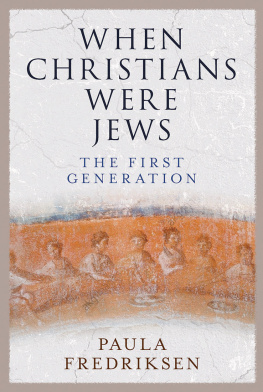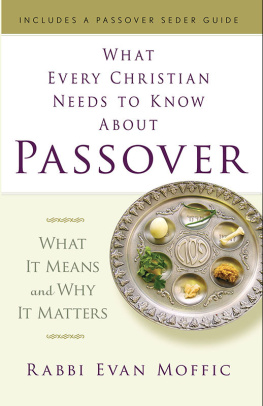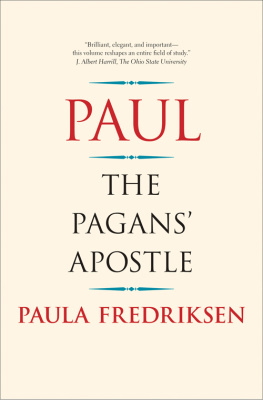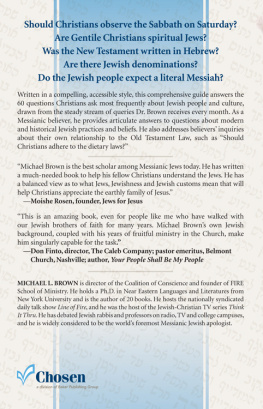WHEN CHRISTIANS WERE JEWS

A LSO BY P AULA F REDRIKSEN
Augustine on Romans: Propositions from the Epistle to the Romans, Unfinished Commentary on the Epistle to the Romans (1982)
From Jesus to Christ: The Origins of the New Testament Images of Jesus (1988; second edition, 2000)
Jesus of Nazareth, King of the Jews: A Jewish Life and the Emergence of Christianity (1999)
Augustine and the Jews: A Christian Defense of Jews and Judaism (2010)
Sin: The Early History of an Idea (2012)
Paul: The Pagans Apostle (2017)
E DITED V OLUMES
Jesus, Judaism, and Christian Anti-Judaism: Reading the New Testament after the Holocaust, with Adele Reinhartz (2002)
On The Passion of the Christ: Exploring the Issues Raised by the Controversial Movie (2004)
Krister among the Jews and Gentiles: An Appreciation of the Life and Work of Krister Stendahl, with Jesper Svartvik (2018)

Published with assistance from the Louis Stern Memorial Fund.
Copyright 2018 by Paula Fredriksen.
All rights reserved.
This book may not be reproduced, in whole or in part, including illustrations, in any form (beyond that copying permitted by Sections 107 and 108 of the U.S. Copyright Law and except by reviewers for the public press), without written permission from the publishers.
Yale University Press books may be purchased in quantity for educational, business, or promotional use. For information, please e-mail (U.K. office).
Set in Electra type by IDS Infotech, Ltd.
Printed in the United States of America.
Library of Congress Control Number: 2018937826
ISBN 978-0-300-19051-9 (hardcover : alk. paper)
A catalogue record for this book is available from the British Library.
This paper meets the requirements of ANSI/NISO Z39.48-1992 (Permanence of Paper).
10 9 8 7 6 5 4 3 2 1
For Yishai and Lulu,
for Shayna and Leah
the next generation.


Pray for the peace of Jerusalem
May those who love you prosper
Peace be within your walls
Psalm 122.67
CONTENTS


PROLOGUE
Peter, James, and John. Paul and his missionary companion, Barnabas. All of these men were Jews, though we identify them with the origins of Christianity. This is because we know that their efforts would eventually lead to the formation of that laterand predominantly gentilereligious community. But they did not know this. Committed to their movements core prophecyThe times are fulfilled, and the Kingdom of God is at hand! Repent, and trust in the good news!they foresaw no extended future. They passionately believed that God was about to fulfill his ancient promises to Israel: to redeem history, to defeat evil, to raise the dead, and to establish a universal reign of justice and peace.
Their immediate source for this good news had been the prophecy of Jesus himself. And in their visions of Jesus raised, his followers hopes were confirmed: Jesus own resurrection could only mean that the general resurrectionthus, the coming of Gods Kingdomtruly was at hand. Now linking the Kingdoms imminent arrival to the victorious return of their messiah, these followers raced to proclaim the good news in what they were sure was a brief wrinkle in time, the Spirit-charged gap between the raising of Jesus and his glorious second coming. They would continue the mission of Jesus by spreading the message of the coming Kingdom in the unpredictably short period between now and soon.
How can we reconstruct the supreme confidence and the compelling convictions of this generationespecially when we know that history did not, in fact, end in the way that they so fervently believed it would? Fortunately, a voice remains from this moment of the movement: the voice of the apostle Paul.
From his earliest letter to his last, Paul affirms the nearness of the End. Sometime in the late 40s C.E. , Paul asserts that he expects both himself and his community in Thessalonika to be alive when Jesus comes back to raise the dead and to gather his elect. The Lord is near, he later tells his assembly in Philippi. To the Corinthians he confides that the period between now and the end of time has already been shortened: the ends of the ages have already arrived. Now is the acceptable time, he exhorts them; Behold, now is the day of salvation! And some time in the late 50s C.E. , just as he is slipping from our view, Paul in his final letter, to the Romans, confidently announces that salvation is even nearer to us than when we first became convinced. The night is far gone. The daythat is, the Last Day, the day of Jesus return and of the establishment of Gods Kingdomis at hand.
Paul is our earliest witness to what would eventually become Christianity. Although he never knew Jesus of Nazareth, and although his letters mention very few of Jesus teachings, on this point, Jesus and he were agreed: Gods Kingdom would dawn in their own day.
Paul never met Jesus. But he did knowand had complicated relationships withsome of the men in the original circle around him: Peter (whom he calls Cephas), John (the son of Zebedee?), James the brother of Jesus, and perhaps as well some of those whom Paul eventually distained as false brothers. From his own account,
Other sources, some familiar and others not, also aid us in this effort. Beyond the New Testaments collection of Pauls letters, we also have the canonical gospels. Mark, Matthew, and Luke are called the synoptic or seen-together gospels, because they are all somehow related to each other, and tell different versions of what is recognizably the same story. And we have in addition the theologically laden (and intriguingly different) fourth gospel, the gospel of John. Crucially, we can also avail ourselves of part 2 of Lukes gospel, namely the Acts of the Apostles.
And we can nest these texts within a considerable collection of other less familiar ones. We have the works of Pauls elder contemporary, the Alexandrian Jewish intellectual Philo. We have the rich library of the Dead Sea Scrolls. We can turn to a wealth of Jewish inscriptions from the western, Greek-speaking Diaspora, especially from those Jewish communities settled in Asia Minor, modern-day Turkey. Various Jewish revelationsboth biblical texts, like the prophecies of Daniel, and now extrabiblical ones, like Jubilees, a rewritten version of Genesislikewise help us to fill in our picture. Paul does not stand alone.
Framing all of these writings, however, and helping us to read them critically and carefully, we have the works of a singular author, who serves us as an indispensable source. Priest, Pharisee, prophet, military leader, war captive, historian: Josephus. Josephus aids us, in crucial ways, in our quest for the assembly of Jesus earliest followers in Jerusalem. Indeed, for almost three decades, in this holy city, he and they would have been neighbors.
Yosef ben Mattityahu was born into an aristocratic priestly family in Jerusalem only a few years after Jesus had died there. His father would have served in the temple under Caiaphas, the high priest in office when Jesus was crucified. As a young man, Josephus likewise served in the temple. He was acquainted with those various sects or schools that shaped late Second Temple Judaism: Sadducees, Pharisees, Essenes, Zealots. He knew or knew of charismatic ascetics, wandering prophets, and various wonder workers. Among these he numbered John the Baptizer and Jesus of Nazareth. He also knew about the community that had formed around Jesus message and memory after his death. And Josephus played a major role in the catastrophe that brought about the end of that community and of the city and the temple that he had loved: Josephus fought in and lived through his peoples war against Rome, which led to the destruction of Jerusalem.
Next page









